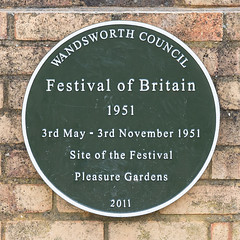

Festival of Britain
man
Aged unknown
Wikidata WikipediaThe Festival of Britain was a national exhibition and fair that reached millions of visitors throughout the United Kingdom in the summer of 1951. Historian Kenneth O. Morgan says the Festival was a "triumphant success" during which people: flocked to the South Bank site, to wander around the Dome of Discovery, gaze at the Skylon, and generally enjoy a festival of national celebration. Up and down the land, lesser festivals enlisted much civic and voluntary enthusiasm. A people curbed by years of total war and half-crushed by austerity and gloom, showed that it had not lost the capacity for enjoying itself....Above all, the Festival made a spectacular setting as a showpiece for the inventiveness and genius of British scientists and technologists. Labour cabinet member Herbert Morrison was the prime mover; in 1947 he started with the original plan to celebrate the centennial of the Great Exhibition of 1851. However, it was not to be another World Fair, for international themes were absent, as was the British Commonwealth. Instead the 1951 festival focused entirely on Britain and its achievements; it was funded chiefly by the government, with a budget of £12 million. The Labour government was losing support and so the implicit goal of the festival was to give the people a feeling of successful recovery from the war's devastation, as well as promoting British science, technology, industrial design, architecture and the arts. The Festival's centrepiece was in London on the South Bank of the Thames. There were events in Poplar (Architecture – Lansbury Estate), Battersea (the Festival Pleasure Gardens), South Kensington (Science) and Glasgow (Industrial Power). Festival celebrations took place in Cardiff, Stratford-upon-Avon, Bath, Perth, Bournemouth, York, Aldeburgh, Inverness, Cheltenham, Oxford, Norwich, Canterbury and elsewhere, and there were touring exhibitions by land and sea. The Festival became a "beacon for change" that proved immensely popular with thousands of elite visitors and millions of popular ones. It helped reshape British arts, crafts, designs and sports for a generation. Journalist Harry Hopkins highlights the widespread impact of the "Festival style". They called it "Contemporary". It was: clean, bright and new.... It caught hold quickly and spread first across London and then across England....In an island hitherto largely given up to gravy browns and dull greens, "Contemporary" boldly espoused strong primary colors.
DbPedia
Commemorated on 1 plaque
Festival of Britain 1951 3rd May - 3rd November 1951 Site of the Festival Pleasure Gardens
Near to Bandstand in Battersea Park , SW11, London, United Kingdom where it was
